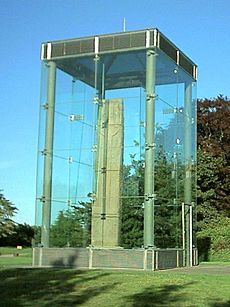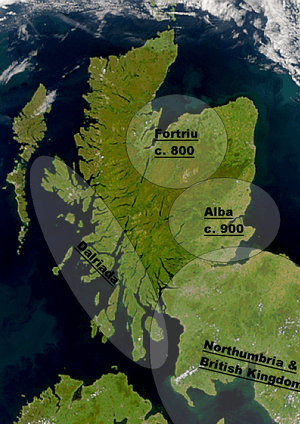Fortriu facts for kids
Fortriu was an important kingdom of the Picts, an ancient people who lived in what is now Scotland. Historians have found records of Fortriu from the 300s to the 900s AD. For a long time, people thought Fortriu was in central Scotland, near Strathearn. But new research suggests it was probably further north, in the areas of Moray and Easter Ross.
Historians use the name Fortriu because we don't know what the people of this kingdom called themselves. Sometimes, the name Fortriu is even used to talk about all of Pictland.
Contents
What's in a Name?
The people of Fortriu didn't leave behind any writings that tell us what they called their kingdom. The first time we see them mentioned is in the late 300s AD. A Roman historian named Ammianus Marcellinus wrote about them in Latin, calling them the Verturiones.
Some experts think the name Verturiones might come from an old word meaning "fortress." This would suggest they were known as the "Fortress People." Other ideas link the name to a word meaning "mighty."
Later, in Irish writings from the 500s to the 900s, Fortriu is often mentioned. They talk about the "King of Fortriu" or "the men of Fortriu." The word Fortriu itself is a modern guess at how the name would have looked in its original form.
Anglo-Saxon writers, like Bede in the 700s, called these people the Wærteras. Today, when scholars write in English, they usually use Fortriu for the kingdom and Wærteras for the people.
Fortriu's Story
Early Days with the Romans
Fortriu first appears in history around 392 AD. The Roman writer Ammianus Marcellinus mentioned the Verturiones as one of the two main groups of Picts. These Picts took part in a big attack on the Roman Empire in 367-368 AD. This event is sometimes called the "Barbarian Conspiracy."
At this time, "Picts" might have just been a Roman word for any British people who weren't under Roman rule. The Verturiones probably lived near the Moray Firth in northern Scotland. We don't know much about their connection to earlier groups in that area. However, discoveries show that the Romans kept in touch with this region.
It's possible that the Verturiones became a larger, more powerful group. This happened in other areas near Roman borders, where smaller groups often joined together.
The attack in 367-368 AD involved not just Picts, but also people from Ireland (called Scotti), and groups from across the North Sea like the Franks and Saxons. This shows that the Verturiones were connected to many different peoples. The attack might have happened because the Roman emperor Valentinian I stopped giving money to these groups.
Fortriu Becomes Powerful
After the 300s, Fortriu isn't mentioned much until 664 AD. But there are signs that it was becoming very strong. For example, Adomnan's book about Columba describes the home of the Pictish king Bridei son of Maelchon (who ruled from 554 to 584) as being near the River Ness. This area is right in the heart of what we now believe was Fortriu.
King Bridei was seen as a very powerful king. He even had an "underking" in Orkney. Irish records suggest that Bridei's power might have spread as far as Dál Riata, a Gaelic kingdom in the west.
By the late 600s, Fortriu had become the most powerful kingdom among the Picts. Historians call this time the Verturian Hegemony, meaning Fortriu was in charge. This was a huge step in uniting the Picts.
Bridei son of Beli was the first king to be clearly called "King of Fortriu" in old records. In 685, he won a major battle against the Northumbrians at the Battle of Dun Nechtain. This victory pushed Northumbrian rule back south of the River Forth. It greatly expanded Fortriu's power. The kings of Fortriu helped create a stronger sense of Pictish identity. They wanted all Picts to see themselves as one people with one king.
The kings of Fortriu kept their control over southern Pictish lands. They did this by placing loyal Gaelic lords and their soldiers in these areas. This created new regions named after important Gaelic families.
Between 731 and 741, King Onuist son of Uurguist led many campaigns. He invaded and conquered the Gaelic kingdom of Dál Riata. Onuist was the first Pictish king known to attack Northumbria and Strathclyde. He might have even attacked Ireland. His rule was incredibly strong, unmatched for over 150 years.
After King Elphin son of Wrad died in 780, Fortriu faced some trouble. There were four kings in a short time, which allowed Dál Riata to become independent again. But when Constantín son of Uurguist became king of Fortriu in 789, he was a strong leader and ruled until his death in 820.
The Viking Age Arrives
Fortriu's power, which had lasted for over 50 years, suddenly ended in 839. This happened because of a major defeat by the Vikings. Old records say that the king of Fortriu, Wen son of Onuist, and his brother, along with the king of Dál Riata, were all killed in this battle. This suggests that Dál Riata was still under Pictish control. Many other people also died.
The fact that so many important leaders were killed suggests this was a huge battle, not just a small raid. It was one of the most important battles in British history. Its exact location is unknown, but it probably happened in the heart of Fortriu, near the Moray Firth.
Viking kings from Dublin, Amlaíb Conung and Auisle, attacked Fortriu in 866. They plundered "the entire Pictish nation." They probably stayed in Fortriu for three years, taking hostages. Then, in 870, they attacked Dumbarton Rock and returned to Dublin in 871. They brought back many captives, including English, Britons, and Picts.
Fortriu Fades Away
Fortriu was still mentioned in records until the early 900s. In 904, the "men of Fortriu" killed a Scandinavian leader. Around this time, records started using the term "King of Alba" instead of "King of Fortriu."
The last time Fortriu is clearly mentioned in Irish records is in 918. At this point, "Men of Fortriu" and "Men of Alba" were used to mean the same thing. An English text from 934 also mentions Fortriu when describing King Aethelstan's attacks in Scotland.
After this, the name Fortriu disappears from history. This suggests that the kingdom broke up into smaller areas during the 900s. These areas became the regions of Moray and Ross. Moray is first mentioned in records between 943 and 954. Ross appears a bit later, between 971 and 976.
Where Was Fortriu?

For a long time, until about 2006, most historians thought Fortriu was in central Scotland. This idea came from the work of historians like E. W. Robertson and W. F. Skene in the 1800s.
Robertson thought Fortriu included areas like Clackmannanshire and Fife. He believed the name came from "Forth Realm," but this idea is now seen as incorrect. Skene thought Fortriu was in Strathearn. He based this on a battle mentioned in old records. However, the location of that battle is also debated.
Despite these debates, the idea that Fortriu was in western Perthshire became widely accepted.
However, new research by historian Alex Woolf has changed this view. An old English record makes it clear that Fortriu was north of the Grampian Mountains. This is the area that Columba visited.
A long poem from the 1100s, called The Prophecy of Berchán, says that Dub, King of Scotland, was killed in the "Plain of Fortriu." Another record says King Dub was killed at Forres, which is in Moray. Other writings confirm that Dub was killed by the men of Moray at Forres.
The same poem also says that Macbeth, King of Scotland, was the "glorious king of Fortriu." Since Macbeth might have been the ruler of Moray before he became king of Scotland, it's possible that Fortriu and Moray were seen as the same place in the Middle Ages. Fortriu is also listed as one of the seven ancient Pictish kingdoms in a 1200s document.
So, there is now little doubt that Fortriu was located in northern Scotland. Most Pictish experts, like James E. Fraser, now agree that Fortriu was centered in Moray and Easter Ross. This is also where many important early Pictish monuments are found.
See also


